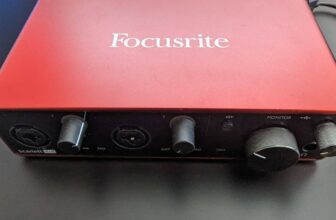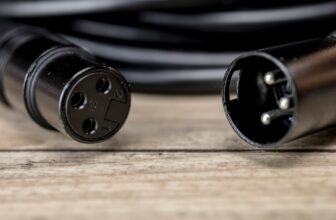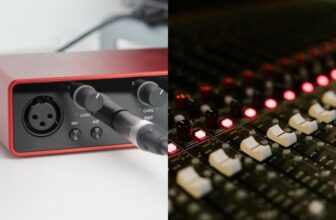Soundproofing vs Acoustic Treatment – What’s the Difference?

Soundproofing prevents the passage of sound inside or outside a room, while acoustic treatment creates a well-balanced environment for recording and listening to audio.
The difference is very important depending on your needs. For example, if you have some very loud instruments such as drums, then you will need to spend a lot of effort to suitably soundproof a room and make sure you use the correct materials. Buying acoustic treatment items like bass traps and diffusers won’t help you soundproof your room very much.
However, if you want to maintain a very well-balanced room for the sake of recording, mixing, and mastering, then you will be a lot more concerned with acoustic treatment.
Avoid Myths About Soundproofing! There are a lot of myths surrounding soundproofing. It’s almost impossible to properly soundproof a room unless you get deep into the construction work of effectively rebuilding your walls, or to go to the next level, building a “room within a room” as described below. Soundproofing takes a whole lot of work and money to do properly.
If you’re renting an apartment or house over the short term, then honestly you will have minimal options on how you can soundproof it effectively.
Contents
What is Acoustic Treatment?

Acoustic treatment involves enhancing the acoustic characteristics of a room in order to make it sound more natural and more pleasing by reducing reflections, reverberations, and echoes from the room. Common items for this purpose are bass traps, acoustic panels, and diffusers.
A well-treated room should help a sound engineer to produce a cleanly recorded audio signal that does not need correction or audio restoration. The recorded audio signal should be as pure and clean as possible.
What Are the Basic Methods of Acoustic Treatment?
There are three basic frequencies that you have to eliminate and absorb from your recorded audio.
Bass traps are used to reduce low frequencies absorbers. Mid to high frequencies are reduced using acoustic Panels, while diffusers are used to scatter the rest of the frequencies.
It is important to know the characteristics of each type of frequency when selecting and installing acoustic materials.
You can use some software applications to test the different audio frequencies in your room to determine which parts of your room need to be treated.
A good and free software application for macOS, Windows, and Linux is REW (Room Equalizer Wizard), which can help you achieve more than just a simple low/mid/high frequencies test.
Or, you can still use the good old testing methods that involve listening to and analyzing a full-spectrum and balanced recording from each part of the room to determine frequency responses organically.
But as a nail of thumb, you’ll have to install bass traps at the room corners where the low frequencies tend to reside and stand there.
When you don’t absorb the low frequencies, these frequencies will hit eachother, causing them to scatter and come back to your ears with the new ones, which messes with the sound and gives you the impression of there being more bass than there actually is.
Acoustic Panels will do the same effect as the Bass Traps, but they are specially made to absorb mid/high frequencies.
Placing the Acoustic Panels in the right places depends on your room test results.
Lastly, there are the diffusers, and as the name indicates, they will diffuse the rest of the frequencies to scatter them, which can be very important for great-sounding audio recordings.
What Is Soundproofing?

Soundproofing prevents the passage of sound inside or outside a room by blocking and absorbing sound waves and reducing vibrations. The general aim of soundproofing is significant noise reduction as full noise isolation is impractical for most purposes.
Just in case you jumped directly to this part of the article, keep in mind the myths around soundproofing as I mentioned earlier, and make sure to manage your own expectations if using basic soundproofing techniques.
How Do You Soundproof a Room?
There are many used techniques in making a soundproof room. Some more affordable options tend to simply reduce the amount of noise leaving a room, whereas advanced techniques eliminate the majority of the noise.
Some basic techniques
- Sealing doors and windows (particularly the gap under your door).
- Using soundproof curtains
- Using thick carpets to reduce the sound and minimize vibrations exiting the room
More advanced techniques
- Adding mass and sound dampening items to your wall and ceiling (See this article for more info)
- Room within a room technique, which involves considerable construction within your room, but it’s highly effective when done correctly.
Room With a Room (Soundproofing Technique).
The room within a room technique is probably one of the best methods to creating an almost fully isolated room. If you want to create a serious recording studio with high-quality recordings then this is a great option.
This soundproofing technique starts with placing a floating floor. A floating floor means that there is a soundproof material between the studio floor and the room floor. In the meantime, this floating floor structure does not touch the room walls.
The second step is to build the isolated studio walls, which will carry the isolated ceiling. After that, you can structure the interior rooms as you planned for your studio layout.
If you want to imagine the final result, it’s like you placed a small box over a piece of rubber inside a bigger box.
There is a lot to this process, we’re talking room infrastructure, doors, windows, electricity, internet, lighting, floor, ceiling, walls, testing the room frequencies, internal acoustic treatment, the interior rooms, placing the near field speakers, and many more things. However, this is just a birds-eye view of the process.
Summary
There is a big difference between acoustic treatment and soundproofing. It’s important to have a clear distinction between these, as they both achieve very different results.
If you want to block sound from entering and exiting a room, you should consider soundproofing. However, if you want to improve the audio environment of your room for the purposes of recording and monitoring, you should think about acoustic treatment. You may need a combination of both techniques.





